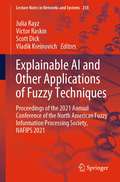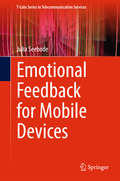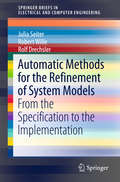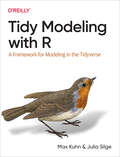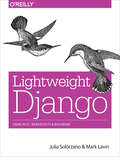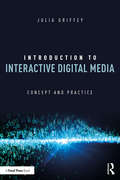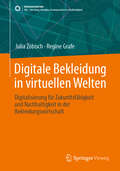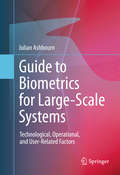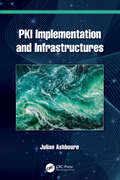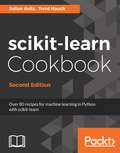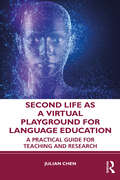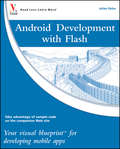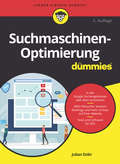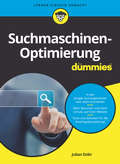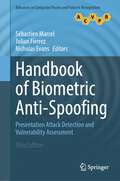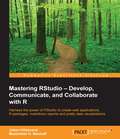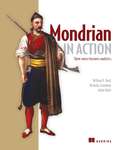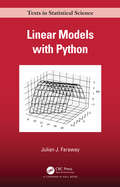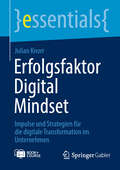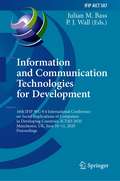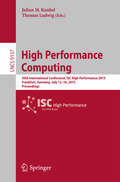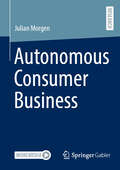- Table View
- List View
Secrets of the Animator
by Julia PeguetBased on the author's own notes compiled over 18 years, this work is intended for both animation students and professionals. This manual is a learning tool focusing exclusively on the work of animators. It provides all the keys to understanding the principles of motion and how to transfer them to characters, whether drawn or modeled, 2D or 3D, or human or animal. Julia Peguet explains the principles of physics applicable to any motion (animation curve, momentum, rebound, etc.) and provides practical tips for stabilizing a puppet, animating a character's mouth and eyes, or even making a character stand out with a particular gait. Sketches and photographs illustrate technical recommendations step by step. Exercises and boxes containing tips and notes are also provided.
Explainable AI and Other Applications of Fuzzy Techniques: Proceedings of the 2021 Annual Conference of the North American Fuzzy Information Processing Society, NAFIPS 2021 (Lecture Notes in Networks and Systems #258)
by Vladik Kreinovich Julia Rayz Victor Raskin Scott DickThis book focuses on an overview of the AI techniques, their foundations, their applications, and remaining challenges and open problems. Many artificial intelligence (AI) techniques do not explain their recommendations. Providing natural-language explanations for numerical AI recommendations is one of the main challenges of modern AI. To provide such explanations, a natural idea is to use techniques specifically designed to relate numerical recommendations and natural-language descriptions, namely fuzzy techniques. This book is of interest to practitioners who want to use fuzzy techniques to make AI applications explainable, to researchers who may want to extend the ideas from these papers to new application areas, and to graduate students who are interested in the state-of-the-art of fuzzy techniques and of explainable AI—in short, to anyone who is interested in problems involving fuzziness and AI in general.
Die Polizei und ihre Unterstützung aus der Luft: Eine kriminalwissenschaftliche Untersuchung polizeilicher Befugnisse beim Einsatz „Unbemannter Luftfahrtsysteme“ (BestMasters)
by Julia RipplIm Rahmen polizeilicher Videoüberwachung gewinnt die Inanspruchnahme von „Luftunterstützung" v. a. durch „unbemannte Luftfahrtsysteme" (ULS) zunehmend an Bedeutung, z. B. bei Vermisstensuchen, Fahndungsmaßnahmen, Observationen, Versammlungen sowie bei Veranstaltungen. Seit 2015 wurde die Ausrüstung bayerischer Polizeibehörden mit Drohnen begonnen und nach der, auch kritisch begleiteten, legislativen Verankerung des Einsatzes von ULS im Jahr 2018 im Bayerischen Polizeiaufgabengesetz (BayPAG) zunehmend forciert. Auch die Entwicklungen im Bereich der sogenannten „intelligenten Videoüberwachung“ werden von bayerischen Polizeibehörden mit Interesse verfolgt. Ziel dieses Buches ist die Klärung der Frage, ob die Bayerische Polizei mit den aktuellen rechtlichen Rahmenbedingungen ULS – trotz bestehender polizei- und kriminalwissenschaftlicher Implikationen, wie z. B. die Durchsetzbarkeit von Betroffenenrechten oder die Auswirkungen von Selektionsprozessen – rechtssicher zur polizeilichen Videoüberwachung bei Versammlungen, für präventivpolizeiliche Zwecke und insbesondere in Form der sogenannten intelligenten Videoüberwachung einsetzen kann.
Emotional Feedback for Mobile Devices
by Julia SeebodeThis book investigates the functional adequacy as well as the affective impression made by feedback messages on mobile devices. It presents an easily adoptable experimental setup to examine context effects on various feedback messages and applies it to auditory, tactile and auditory-tactile feedback messages. This approach provides insights into the relationship between the affective impression and functional applicability of these messages as well as an understanding of the influence of unimodal components on the perception of multimodal feedback messages. The developed paradigm can also be extended to investigate other aspects of context and used to investigate feedback messages in modalities other than those presented. The book uses questionnaires implemented on a Smartphone, which can easily be adopted for field studies to broaden the scope even wider. Finally, the book offers guidelines for the design of system feedback.
Automatic Methods for the Refinement of System Models: From the Specification to the Implementation (SpringerBriefs in Electrical and Computer Engineering)
by Julia Seiter Robert Wille Rolf DrechslerThis book provides a comprehensive overview of automatic model refinement, which helps readers close the gap between initial textual specification and its desired implementation. The authors enable readers to follow two "directions" for refinement: Vertical refinement, for adding detail and precision to single description for a given model and Horizontal refinement, which considers several views on one level of abstraction, refining the system specification by dedicated descriptions for structure or behavior. The discussion includes several methods which support designers of electronic systems in this refinement process, including verification methods to check automatically whether a refinement has been conducted as intended.
Tidy Modeling with R: A Framework for Modeling in the Tidyverse
by Max Kuhn Julia SilgeGet going with tidymodels, a collection of R packages for modeling and machine learning. Whether you're just starting out or have years of experience with modeling, this practical introduction shows data analysts, business analysts, and data scientists how the tidymodels framework offers a consistent, flexible approach for your work.RStudio engineers Max Kuhn and Julia Silge demonstrate ways to create models by focusing on an R dialect called the tidyverse. Software that adopts tidyverse principles shares both a high-level design philosophy and low-level grammar and data structures, so learning one piece of the ecosystem makes it easier to learn the next. You'll understand why the tidymodels framework has been built to be used by a broad range of people.With this book, you will:Learn the steps necessary to build a model from beginning to endUnderstand how to use different modeling and feature engineering approaches fluentlyExamine the options for avoiding common pitfalls of modeling, such as overfittingLearn practical methods to prepare your data for modelingTune models for optimal performanceUse good statistical practices to compare, evaluate, and choose among models
Lightweight Django: Using REST, WebSockets, and Backbone
by Mark Lavin Julia SolórzanoHow can you take advantage of the Django framework to integrate complex client-side interactions and real-time features into your web applications? Through a series of rapid application development projects, this hands-on book shows experienced Django developers how to include REST APIs, WebSockets, and client-side MVC frameworks such as Backbone.js into new or existing projects.Learn how to make the most of Django’s decoupled design by choosing the components you need to build the lightweight applications you want. Once you finish this book, you’ll know how to build single-page applications that respond to interactions in real time. If you’re familiar with Python and JavaScript, you’re good to go.Learn a lightweight approach for starting a new Django projectBreak reusable applications into smaller services that communicate with one anotherCreate a static, rapid prototyping site as a scaffold for websites and applicationsBuild a REST API with django-rest-frameworkLearn how to use Django with the Backbone.js MVC frameworkCreate a single-page web application on top of your REST APIIntegrate real-time features with WebSockets and the Tornado networking libraryUse the book’s code-driven examples in your own projects
Introduction to Interactive Digital Media: Concept and Practice
by Julia V. GriffeyThis book offers a clearly written and engaging introduction to the basics of interactive digital media. As our reliance on and daily usage of websites, mobile apps, kiosks, games, VR/AR and devices that respond to our commands has increased, the need for practitioners who understand these technologies is growing. Author Julia Griffey provides a valuable guide to the fundamentals of this field, offering best practices and common pitfalls throughout. The book also notes opportunities within the field of interactive digital media for professionals with different types of skills, and interviews with experienced practitioners offer practical wisdom for readers. Additional features of this book include: An overview of the history, evolution and impact of interactive media; A spotlight on the development process and contributing team members; Analysis of the components of interactive digital media and their design function (graphics, animation, audio, video, typography, color); An introduction to coding languages for interactive media; and A guide to usability in interactive media. Introduction to Interactive Digital Media will help both students and professionals understand the varied creative, technical, and collaborative skills needed in this exciting and emerging field.
Digitale Bekleidung in virtuellen Welten: Digitalisierung für Zukunftsfähigkeit und Nachhaltigkeit in der Bekleidungswirtschaft (SDG - Forschung, Konzepte, Lösungsansätze zur Nachhaltigkeit)
by Regine Grafe Julia ZöbischDie Nutzung von digitaler Bekleidung als Verkaufsgut bietet eine Chance für effizienzbasierte Veränderungen in der Bekleidungstechnik, da insbesondere zeit- und materialintensive Prozesse entfallen bzw. deutlich reduziert werden können. Außerdem generiert die Transformation vom physischen zum digitalen Modedesign zusätzliche Marktsegmente und kann damit gleichzeitig das wirtschaftliche Innovationspotenzial der Branche erweitern. Der Bedarf an digitaler Bekleidung wird zu neuen Innovationen auf dem Gebiet der Software-Entwicklung führen, neue technische Schnittmengen, z. B. zur Gaming-Branche, generieren und damit gleichzeitig ein neues Feld auf dem Arbeitsmarkt für Einsteiger aus der Gaming-Branche schaffen.Dieses Buch präsentiert die Trends, die es derzeit in Sachen virtueller Bekleidung und den dafür sich entwickelnden Markt gibt. Ausgehend von der konventionellen Produktentwicklung in der Bekleidungstechnik und der digitalen Unterstützung durch 2D- sowie 3D-Design-Entwicklung soll aufgezeigt werden, welche produktionstechnischen Transfermöglichkeiten sich aktuell auf dem Markt für Bekleidung abzeichnen.
Guide to Biometrics for Large-Scale Systems
by Julian AshbournThis book considers biometric technology in a broad light, integrating the concept seamlessly into mainstream IT, while discussing the cultural attitudes and the societal impact of identity management. Features: summarizes the material covered at the beginning of every chapter, and provides chapter-ending review questions and discussion points; reviews identity verification in nature, and early historical interest in anatomical measurement; provides an overview of biometric technology, presents a focus on biometric systems and true systems integration, examines the concept of identity management, and predicts future trends; investigates performance issues in biometric systems, the management and security of biometric data, and the impact of mobile devices on biometrics technology; explains the equivalence of performance across operational nodes, introducing the APEX system; considers the legal, political and societal factors of biometric technology, in addition to user psychology and other human factors.
PKI Implementation and Infrastructures
by Julian AshbournThe concept of a PKI (public key infrastructure) has been around for decades, but it is one strand of IT which has taken an extraordinarily long time to come to fruition within the mainstream. This is mostly because implementing a PKI is time consuming and difficult. Maintaining a PKI is equally time consuming and even more difficult within the real world of mergers and acquisitions against a backdrop of ever-changing technology. Many organisations simply give up and hand everything over to a third party who promises to manage everything on their behalf. This is generally not a good idea and simply delays the inevitability of failures and misunderstood complexity. This book explores all the aspects of implementing and maintaining a PKI that the other books on the subject seem to miss. It reflects decades of hard-won experience, not only in PKI, not only in IT, not only in electronics, but in business, government agencies and academia alike. The book also explores the existence of a PKI alongside other technologies, such as biometrics, and against an ever-changing world of development methodologies. This last point is particularly relevant at this time as we are in the middle of a quiet, but all encompassing revolution in this respect. Consequently, this is the one book on PKI that you have to have on your shelf, whether you be a company director, IT manager, government minister or teacher of IT. It is the book which fills in all the gaps left in the literature and treads paths which others fear to tread. You will enjoy it enormously if you are from an IT background.
scikit-learn Cookbook - Second Edition
by Julian AvilaLearn to use scikit-learn operations and functions for Machine Learning and deep learning applications. About This Book • Handle a variety of machine learning tasks effortlessly by leveraging the power of scikit-learn • Perform supervised and unsupervised learning with ease, and evaluate the performance of your model • Practical, easy to understand recipes aimed at helping you choose the right machine learning algorithm Who This Book Is For Data Analysts already familiar with Python but not so much with scikit-learn, who want quick solutions to the common machine learning problems will find this book to be very useful. If you are a Python programmer who wants to take a dive into the world of machine learning in a practical manner, this book will help you too. What You Will Learn • Build predictive models in minutes by using scikit-learn • Understand the differences and relationships between Classification and Regression, two types of Supervised Learning. • Use distance metrics to predict in Clustering, a type of Unsupervised Learning • Find points with similar characteristics with Nearest Neighbors. • Use automation and cross-validation to find a best model and focus on it for a data product • Choose among the best algorithm of many or use them together in an ensemble. • Create your own estimator with the simple syntax of sklearn • Explore the feed-forward neural networks available in scikit-learn In Detail Python is quickly becoming the go-to language for analysts and data scientists due to its simplicity and flexibility, and within the Python data space, scikit-learn is the unequivocal choice for machine learning. This book includes walk throughs and solutions to the common as well as the not-so-common problems in machine learning, and how scikit-learn can be leveraged to perform various machine learning tasks effectively. The second edition begins with taking you through recipes on evaluating the statistical properties of data and generates synthetic data for machine learning modelling. As you progress through the chapters, you will comes across recipes that will teach you to implement techniques like data pre-processing, linear regression, logistic regression, K-NN, Naive Bayes, classification, decision trees, Ensembles and much more. Furthermore, you'll learn to optimize your models with multi-class classification, cross validation, model evaluation and dive deeper in to implementing deep learning with scikit-learn. Along with covering the enhanced features on model section, API and new features like classifiers, regressors and estimators the book also contains recipes on evaluating and fine-tuning the performance of your model. By the end of this book, you will have explored plethora of features offered by scikit-learn for Python to solve any machine learning problem you come across. Style and Approach This book consists of practical recipes on scikit-learn that target novices as well as intermediate users. It goes deep into the technical issues, covers additional protocols, and many more real-live examples so that you are able to implement it in your daily life scenarios.
Second Life as a Virtual Playground for Language Education: A Practical Guide for Teaching and Research
by Julian ChenThis insightful book offers language teachers and teachers in training the opportunity to delve into 3D virtual worlds and see the benefits they provide for effective language teaching. Based on a decade of experience teaching and researching in Second Life (SL), Chen demystifies the dos and don’ts of SL teaching and research, whilst vividly walking readers through each step of the journey. Written in an accessible, jargon-free, and personalised tone, the book is divided into three parts. Part I builds the foundation in SL research, task-based language teaching (TBLT), and understanding fundamental skills for SL teaching. Part II showcases the author’s SL teaching blog that generously unveils their task-based, SL-enabled lessons, participant observations, critical reflections, and lessons learned from each SL session. Part III is complete with the highlights of the author’s SL research and hands-on resources and tips for readers. Each chapter also features a "Checkpoint" section to gauge reader understanding of chapter content, followed by a "Your Task" section to promote learning by doing in SL. Teachers and curriculum designers will find the well-detailed and guided lesson planning useful when starting their first SL class. Graduate students and novice researchers will also find the systematically recorded data collection helpful for their SL research.
Android Development with Flash
by Julian DolceThe visual guide to developing for one of the world's hottest new mobile platforms, the Android OSThe Android operating system works on phones that combine a camera, Web browser, e-mail, GPS, and mapping tool into a single accessible pocket-sized unit, and can function on computers, as well. Aimed at visual learners and packed with hundreds of screen shots, this guide brings Flash developers up to speed on the necessary factors to take into account when developing for this touch-based, mobile platform. Experienced Flash developer Julian Dolce escorts you through the process of creating applications for the Android OS using the Flash CS5 development platform and informs you of best practices to try as well as common pitfalls to avoid.Guides you step by step through the process of creating applications for the Android OS using Flash CS5Explores the capabilities and limitations of developing apps for the Android OSPoints out common pitfalls and teaches you best practicesFeatures hundreds of screen shots to assist with visual learningAndroid Development with Flash: Your visual blueprint for developing mobile apps gets you on your way to developing apps for Android... in a flash!
Suchmaschinen-Optimierung für Dummies (Für Dummies)
by Julian DzikiSie haben ein Unternehmen gegründet und Ihre Website geht demnächst online? Sie sind gerüstet für zahlreiche Besucher und hoffen auf hohe Umsätze? Dann ist es Zeit für das Feintuning. Dieses Buch zeigt Ihnen, wie Ihre Website von Google besser gefunden wird und wie Sie bei Google ganz nach oben kommen. Finden Sie die richtigen Suchbegriffe und stimmen Sie Ihre Inhalte darauf ab, optimieren Sie Ihre Snippets und unterstützen Sie den Google-Crawler beim Erfassen der Seiten. Zahlreiche Beispiele und Anekdoten aus der Praxis sorgen nicht nur für ein gutes Ranking, sondern auch für Spaß beim Lesen.
Suchmaschinen-Optimierung für Dummies (Für Dummies)
by Julian DzikiSie haben ein Unternehmen gegründet und Ihre Website geht demnächst online? Sie sind gerüstet für zahlreiche Besucher und hoffen auf hohe Umsätze? Dann ist es Zeit für das Feintuning. Dieses Buch zeigt Ihnen, wie Ihre Website von Google besser gefunden wird und wie Sie bei Google ganz nach oben kommen. Finden Sie die richtigen Suchbegriffe und stimmen Sie Ihre Inhalte darauf ab, optimieren Sie Ihre Snippets und unterstützen Sie den Google-Crawler beim Erfassen der Seiten. Zahlreiche Beispiele und Anekdoten aus der SEO-Praxis sorgen für ein gutes Ranking und für Spaß beim Lesen.
Konzeption eines IT-basierten Entscheidungsunterstützungssystems für die Gestaltung dezentraler Datenhaltungen in analytischen Informationssystemen
by Julian ErethDer steigende Stellenwert von Daten als Ressource und die zunehmende Ausweitung des Aufgabenspektrums der IT-basierten Entscheidungsunterstützung verändern die logischen Architekturen analytischer Informationssysteme. Insbesondere die Datenhaltungen entwickeln sich vermehrt von zentralen Konstrukten hin zu dezentralen Konglomeraten verschiedenster Speicheransätze. Die zunehmend heterogenen Technologien und die häufig unzureichenden Erfahrungen mit neuartigen Konzepten erhöhen die Komplexität in der Planung und dem Betrieb analytischer Systemlandschaften. Das Ziel dieser Arbeit ist daher die Konzeption eines IT-basierten Entscheidungsunterstützungssystems für die Gestaltung dezentraler Datenhaltungen in analytischen Informationssystemen. Es wird ein Fachkonzept für die Überführung von Architekturansätzen aus realen Umgebungen in abstrahierte Architekturmuster sowie für die fallspezifische Ableitung von Handlungsempfehlungen entwickelt, prototypisch als Software-Werkzeug implementiert und evaluiert. Das hierbei entwickelte Verständnis eines Architekturmusters ermöglicht durch die Kombination von fachlichen-orientierten analytischen Capabilitites und technischen Aspekten eine ganzheitliche und systematische Unterstützung von IT-Architekturentscheidungen.
Handbook of Biometric Anti-Spoofing: Presentation Attack Detection and Vulnerability Assessment (Advances in Computer Vision and Pattern Recognition)
by Nicholas Evans Sébastien Marcel Julian FierrezThe third edition of this authoritative and comprehensive handbook is the definitive work on the current state of the art of Biometric Presentation Attack Detection (PAD) – also known as Biometric Anti-Spoofing. Building on the success of the previous editions, this thoroughly updated third edition has been considerably revised to provide even greater coverage of PAD methods, spanning biometrics systems based on face, fingerprint, iris, voice, vein, and signature recognition. New material is also included on major PAD competitions, important databases for research, and on the impact of recent international legislation. Valuable insights are supplied by a selection of leading experts in the field, complete with results from reproducible research, supported by source code and further information available at an associated website.Topics and features: reviews the latest developments in PAD for fingerprint biometrics, covering recent technologies like Vision Transformers, and review of competition series; examines methods for PAD in iris recognition systems, the use of pupil size measurement or multiple spectra for this purpose; discusses advancements in PAD methods for face recognition-based biometrics, such as recent progress on detection of 3D facial masks and the use of multiple spectra with Deep Neural Networks; presents an analysis of PAD for automatic speaker recognition (ASV), including a study of the generalization to unseen attacks; describes the results yielded by key competitions on fingerprint liveness detection, iris liveness detection, and face anti-spoofing; provides analyses of PAD in finger-vein recognition, in signature biometrics, and in mobile biometrics; includes coverage of international standards in PAD and legal aspects of image manipulations like morphing.This text/reference is essential reading for anyone involved in biometric identity verification, be they students, researchers, practitioners, engineers, or technology consultants. Those new to the field will also benefit from a number of introductory chapters, outlining the basics for the most important biometrics.This text/reference is essential reading for anyone involved in biometric identity verification, be they students, researchers, practitioners, engineers, or technology consultants. Those new to the field will also benefit from a number of introductory chapters, outlining the basics for the most important biometrics.
Mastering RStudio – Develop, Communicate, and Collaborate with R
by Maximilian H. Nierhoff Julian HillebrandHarness the power of RStudio to create web applications, R packages, markdown reports and pretty data visualizations About This Book * Discover the multi-functional use of RStudio to support your daily work with R code * Learn to create stunning, meaningful, and interactive graphs and learn to embed them into easy communicable reports using multiple R packages * Develop your own R packages and Shiny web apps to share your knowledge and collaborate with others Who This Book Is For This book is aimed at R developers and analysts who wish to do R statistical development while taking advantage of RStudio's functionality to ease their development efforts. R programming experience is assumed as well as being comfortable with R's basic structures and a number of functions. What You Will Learn * Discover the RStudio IDE and details about the user interface * Communicate your insights with R Markdown in static and interactive ways * Learn how to use different graphic systems to visualize your data * Build interactive web applications with the Shiny framework to present and share your results * Understand the process of package development and assemble your own R packages * Easily collaborate with other people on your projects by using Git and GitHub * Manage the R environment for your organization with RStudio and Shiny server * Apply your obtained knowledge about RStudio and R development to create a real-world dashboard solution In Detail RStudio helps you to manage small to large projects by giving you a multi-functional integrated development environment, combined with the power and flexibility of the R programming language, which is becoming the bridge language of data science for developers and analyst worldwide. Mastering the use of RStudio will help you to solve real-world data problems. This book begins by guiding you through the installation of RStudio and explaining the user interface step by step. From there, the next logical step is to use this knowledge to improve your data analysis workflow. We will do this by building up our toolbox to create interactive reports and graphs or even web applications with Shiny. To collaborate with others, we will explore how to use Git and GitHub with RStudio and how to build your own packages to ensure top quality results. Finally, we put it all together in an interactive dashboard written with R. Style and approach An easy-to-follow guide full of hands-on examples to master RStudio. Beginning from explaining the basics, each topic is explained with a lot of details for every feature.
Mondrian in Action
by Julian Hyde William Back Nicholas GoodmanSummaryMondrian in Action teaches business users and developers how to use Mondrian and related tools for strategic business analysis. You'll learn how to design and populate a data warehouse and present the data via a multidimensional model. You'll follow examples showing how to create a Mondrian schema and then expand it to add basic security based on the users' roles.About the TechnologyMondrian is an open source, lightning-fast data analysis engine designed to help you explore your business data and perform speed-of-thought analysis. Mondrian can be integrated into a wide variety of business analysis applications and learning it requires no specialized technical knowledge.About this BookMondrian in Action teaches you to use Mondrian for strategic business analysis. In it, you'll learn how to organize and present data in a multidimensional manner. You'll follow apt and thoroughly explained examples showing how to create a Mondrian schema and then expand it to add basic security based on users' roles. Developers will discover how to integrate Mondrian using its olap4j Java API and web service calls via XML for Analysis.Written for developers building data analysis solutions. Appropriate for tech-savvy business users and DBAs needing to query and report on data.Purchase of the print book includes a free eBook in PDF, Kindle, and ePub formats from Manning Publications.What's InsideMondrian from the ground up—no experience requiredA primer on business analyticsUsing Mondrian with a variety of leading applicationsOptimizing and restricting business data for fast, secure analysisAbout the AuthorsWilliam D. Back is an Enterprise Architect and Director of Pentaho Services. Nicholas Goodman is a Business Intelligence pro who has authored training courses on OLAP and Mondrian. Julian Hyde founded Mondrian and is the project's lead developer.Table of ContentsBeyond reporting: business analyticsMondrian: a first lookCreating the data mart Multidimensional modeling: making analytics data accessibleHow schemas growSecuring dataMaximizing Mondrian performanceDynamic securityWorking with Mondrian and PentahoDeveloping with MondrianAdvanced analytics
Linear Models with Python (Chapman & Hall/CRC Texts in Statistical Science)
by Julian J. FarawayPraise for Linear Models with R: This book is a must-have tool for anyone interested in understanding and applying linear models. The logical ordering of the chapters is well thought out and portrays Faraway’s wealth of experience in teaching and using linear models. … It lays down the material in a logical and intricate manner and makes linear modeling appealing to researchers from virtually all fields of study. -Biometrical Journal Throughout, it gives plenty of insight … with comments that even the seasoned practitioner will appreciate. Interspersed with R code and the output that it produces one can find many little gems of what I think is sound statistical advice, well epitomized with the examples chosen…I read it with delight and think that the same will be true with anyone who is engaged in the use or teaching of linear models. -Journal of the Royal Statistical Society Like its widely praised, best-selling companion version, Linear Models with R, this book replaces R with Python to seamlessly give a coherent exposition of the practice of linear modeling. Linear Models with Python offers up-to-date insight on essential data analysis topics, from estimation, inference and prediction to missing data, factorial models and block designs. Numerous examples illustrate how to apply the different methods using Python. Features: Python is a powerful, open source programming language increasingly being used in data science, machine learning and computer science. Python and R are similar, but R was designed for statistics, while Python is multi-talented. This version replaces R with Python to make it accessible to a greater number of users outside of statistics, including those from Machine Learning. A reader coming to this book from an ML background will learn new statistical perspectives on learning from data. Topics include Model Selection, Shrinkage, Experiments with Blocks and Missing Data. Includes an Appendix on Python for beginners. Linear Models with Python explains how to use linear models in physical science, engineering, social science and business applications. It is ideal as a textbook for linear models or linear regression courses.
Erfolgsfaktor Digital Mindset: Impulse und Strategien für die digitale Transformation im Unternehmen (essentials)
by Julian KnorrDieses essential beschäftigt sich mit den Treibern der digitalen Transformation und wie Unternehmen ihre Geschäftsmodelle, Prozesse und Technologien anpassen können, um zukunftsfähig zu bleiben. Gerade wenn tiefgreifende Veränderungen notwendig sind, wird das „Digital Mindset“ der Mitarbeiter*innen zum zentralen Erfolgsfaktor der digitalen Transformation. Wer ist Hinterfrager und wer Befürworter – wer ist Brückenbauer und wer digitaler Nerd? Digitalisierungsexperte Julian Knorr plädiert für eine ganzheitliche Betrachtung von Unternehmen für einen nachhaltigen Wandel und liefert Strategien sowie praktische Tipps für eine erfolgreiche Transformation.
Information and Communication Technologies for Development: 16th IFIP WG 9.4 International Conference on Social Implications of Computers in Developing Countries, ICT4D 2020, Manchester, UK, June 10–11, 2020, Proceedings (IFIP Advances in Information and Communication Technology #587)
by Julian M. Bass P. J. WallThis book constitutes the refereed proceedings of the 16th IFIP WG 9.4 International Conference on Social Implications of Computers in Developing Countries, ICT4D 2020, which was supposed to be held in Salford, UK, in June 2020, but was held virtually instead due to the COVID-19 pandemic. The 18 revised full papers presented were carefully reviewed and selected from 29 submissions. The papers present a wide range of perspectives and disciplines including (but not limited to) public administration, entrepreneurship, business administration, information technology for development, information management systems, organization studies, philosophy, and management. They are organized in the following topical sections: digital platforms and gig economy; education and health; inclusion and participation; and business innovation and data privacy.
High Performance Computing
by Thomas Ludwig Julian M. KunkelThis book constitutes the refereed proceedings of the 30th International Conference, ISC High Performance 2015, [formerly known as the International Supercomputing Conference] held in Frankfurt, Germany, in July 2015. The 27 revised full papers presented together with 10 short papers were carefully reviewed and selected from 67 submissions. The papers cover the following topics: cost-efficient data centers, scalable applications, advances in algorithms, scientific libraries, programming models, architectures, performance models and analysis, automatic performance optimization, parallel I/O and energy efficiency.
Autonomous Consumer Business
by Julian MorgenEine immer mehr digital vernetzte Welt führt zu einer sehr großen Menge von unterschiedlichen Daten, die in Echtzeit generiert werden („Big Data“). Ein großer Teil dieser Datenproduzenten sind Nutzer von Social Media oder auch smarten Geräten, wie bspw. Fitnesstrackern oder mit dem Internet verbundenen Waschmaschinen („IoT“). Unternehmen, die sich diese Daten aus der direkten Lebenswelt der Konsumenten zu Nutze machen, können sehr präzise Einblicke bspw. über Einstellungen, Verhalten oder auch die Bedürfnisse potenzieller Kunden erhalten, wodurch der Weg zu einer „automatisierten Vermarktung“ geebnet wird. Zielsetzung dieses Buches ist die Entwicklung eines Konzeptes für ein Autonomous Consumer Business (ACB), das als maximal eigenständig agierendes und durch Künstliche Intelligenz getragenes Geschäftsmodell verstanden wird, bei dem Unternehmen die Bedürfnisse auf der Konsumentenseite automatisch erkennen und durch entsprechende Leistungsangebote befriedigen können. Weiterhin werden zentrale Bestimmungsgrößen, welche die konsumentenseitige Inanspruchnahme eines ACB im besonderen Maße beeinflussen, sowie potenzielle Kundengruppen empirisch identifiziert, wodurch Hinweise zur konkreten Ausgestaltung eines ACB gewonnen werden können.

